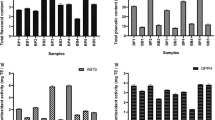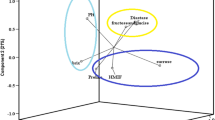Abstract
Bee bread is a bee product that is formed by the mixture of honey, pollen, and secretion from the salivary glands of the bee. Research on bee bread is very limited compared to honey and pollen studies, but in recent years, with the increasing visibility of the product in the market, research on bee bread has also increased. This study was conducted to evaluate the chemical profile and antioxidant activity of bee breads collected from Anatolia. The individual sugars and organic acids were analyzed by a rapid and green capillary electrophoretic method. Fructose (11.6–32.1 g/100 g) and glucose (6.21–21.5 g/100 g) were the major sugars. Bee bread samples contained a wide range of organic acids. In all of the bee bread samples, gluconic acid (43.6–63.2 g/kg) was the predominant organic acid. Lactic acid, with a concentration ranging from 17.6 to 21.7 g/kg, was the second-highest organic acid. Total phenolic contents of the bee bread samples, ranging from 11.9 to 32.4 mg gallic acid equivalents (GAE)/g, were determined using Folin-Ciocalteu's method. DPPH radical scavenging activities and ferric reducing antioxidant power (FRAP) of the samples were evaluated. Finally, principal component analysis (PCA) analysis was performed using all data. The bee bread samples were clustered according to their site of collection. The results of the study will contribute to the data to be created from different parts of the world in the coming days for bee bread, which has a commercial value as food and complementary medicine.
Graphical abstract






Similar content being viewed by others
Data availability
Data sharing is not applicable to this article.
References
Kolaylı S, Keskin M (2020). In: Rahman AU (ed) Natural bee products and their apitherapeutic applications. Elsevier, Amsterdam, The Netherlands, pp 175–196
Giampieri F, Luis Quiles J, Cianciosi D, Forbes-Hernandez TY, Orantes-Bermejo FJ, Alvarez-Suarez JM et al (2022) Bee products: an emblematic example of underutilized sources of bioactive compounds. J Agric Food Chem 70:6833–6848
Nainu F, Masyita A, Bahar MA, Raihan M, Prova SR, Mitra S et al (2021) Pharmaceutical prospects of bee products: special focus on anticancer, antibacterial, antiviral, and antiparasitic properties. Antibiotics (Basel) 10:822
Kafantaris I, Amoutzias GD, Mossialos D (2021) Foodomics in bee product research: a systematic literature review. Eur Food Res Technol 247:309–331
Pita-Calvo C, Vázquez M (2018) Honeydew honeys: a review on the characterization and authentication of botanical and geographical origins. J Agric Food Chem 66:2523–2537
Speer K, Tanner N, Kölling-Speer I, Rohleder A, Zeippert L, Beitlich N et al (2021) Cornflower honey as a model for authentication of unifloral honey using classical methods combined with plant-based marker substances such as lumichrome. J Agric Food Chem 69:11406–11416
Qiao J, Chen L, Kong L, Dong J, Zhou Z, Zhang H (2020) Characteristic components and authenticity evaluation of rape, acacia, and linden honey. J Agric Food Chem 68:9776–9788
Kalaycıoğlu Z, Kaygusuz H, Döker S, Kolaylı S, Erim FB (2017) Characterization of Turkish honeybee pollens by principal component analysis based on their individual organic acids, sugars, minerals, and antioxidant activities. LWT Food Sci Technol 84:402–408
Kalaycıoğlu Z (2022) Characterization of Anatolian bee breads by principal component analysis based on their physicochemical and chemical characteristic. J Apitherapy Nat 5:14–26
Tezcan F, Kolayli S, Ulusoy H, Erim FB (2011) Evaluation of organic acid, saccharide composition and antioxidant properties of some authentic Turkish honeys. J Food Nutr Res 50(1):33–40
Kaygusuz H, Tezcan F, Erim FB, Yıldız O, Sahin H, Can Z et al (2016) Characterization of Anatolian honeys based on minerals, bioactive components and principal component analysis. LWT Food Sci Technol 68:273–279
Aftab J, Kalaycıoğlu Z, Kolaylı S, Erim FB (2021) Sample stacking–capillary electrophoretic determination of nitrate and nitrite contents as nitric oxide metabolites in honey varieties originated from Anatolia. Acta Aliment 50:574–582
Kalaycıoğlu Z, Karadeniz HS, Berker B (2021) Naturally occuring nitrate and nitrite in nutrients: determination in anatolian honey-bee pollens by capillary electrophoresis. AURUM J Eng Syst Archit 5:139–148
Akay M, Kalaycıoğlu Z, Kolaylı S, Berker B (2021) Comparative determination of melittin by capillary electrophoretic methods. J Turk Chem Soc A Chem 8:1211–1216
Vasquez A, Olofsson TC (2009) The lactic acid bacteria involved in the production of bee pollen and bee bread. J Apic Res 48:189–195
Bakour M, Laaroussi H, Ousaaid D, El Ghouizi A, Es-Safi I, Mechchate H et al (2022) Bee bread as a promising source of bioactive molecules and functional properties: an up-to-date review. Antibiotics 11:203
Bakour M, Fernandes A, Barros L, Sokovic M, Ferreira IC, Lyoussi B (2019) Bee bread as a functional product: Chemical composition and bioactive properties. LWT Food Sci Technol 109:276–282
Mohammad SM, Mahmud-Ab-Rashid NK, Zawawi N (2021) Stingless bee-collected pollen (bee bread): chemical and microbiology properties and health benefits. Molecules 26:954
Didaras NA, Karatasou K, Dimitriou TG, Amoutzias GD, Mossialos D (2020) Antimicrobial activity of bee-collected pollen and beebread: state of the art and future perspectives. Antibiotics 9:811
Pełka K, Bucekova M, Godocikova J, Szweda P, Majtan J (2022) Glucose oxidase as an important yet overlooked factor determining the antibacterial activity of bee pollen and bee bread. Eur Food Res Technol 248:2929–2939
Dai D, Qiu K, Zhang HJ, Wu SG, Han YM, Wu YY et al (2021) Organic acids as alternatives for antibiotic growth promoters alter the intestinal structure and microbiota and improve the growth performance in broilers. Front Microbiol 11:618144
Louveaux J, Maurizio A, Vorwohl G (1978) Methods of melissopalynology. Bee World 59:139–157
Gürel A, Hızal J, Oztekin N, Erim FB (2006) CE determination of carbohydrates using a dipeptide as separation electrolyte. Chromatographia 64:321–324
Singleton VL, Rossi JA (1965) Colorimetry of total phenolics with phosphomolybdic-phosphotungstic acid reagents. Am J Enol Vitic 16:144–158
Blois MS (1958) Antioxidant determinations by the use of a stable free radical. Nature 18:1199–1200
Benzie IFF, Strain JJ (1996) The ferric reducing ability of plasma (FRAP) as a measure of “Antioxidant Power”: The FRAP assay. Anal Biochem 239:70–76
Brugnerotto P, Della Betta F, Gonzaga LV, Fett R, Oliveira Costa AC (2019) A capillary electrophoresis method to determine aliphatic organic acids in bracatinga honeydew honey and floral honey. J Food Compos Anal 82:103243
Dos Santos AC, Biluca FC, Brugnerotto P, Gonzaga LV, Oliveira Costa AC, Fett R (2022) Brazilian stingless bee honey: physicochemical properties and aliphatic organic acids content. Int Food Res J 158:111516
Olofsson TC, Vasquez A (2008) Detection and identification of a novel lactic acid bacterial flora within the honey stomach of the honeybee Apis mellifera. Curr Microbiol 57:356–363
Kieliszek M, Piwowarek K, Kot AM, Błażejak S, Chlebowska-Śmigiel A, Wolska I (2018) Pollen and bee bread as new health-oriented products: A review. Trends Food Sci Technol 71:170–180
Bartai DG, Cornea-Cipcigan M, Margaoan R, Vodnar DC (2022) Biotechnological processes simulating the natural fermentation process of bee bread and therapeutic properties—an overview. Front Nutr 9:871896
Dranca F, Ursachi F, Oroian M (2020) Bee bread: physicochemical characterization and phenolic content extraction optimization. Foods 9:1358
Çelik S, Gerçek YC, Özkök A, Bayram NE (2022) Organic acids and their derivatives: minor components of bee pollen, bee bread, royal jelly and bee venom. Eur Food Res Technol 248:3037–3057
Tomás A, Falcão SI, Russo-Almeida P, Vilas-Boas M (2017) Potentialities of beebread as a food supplement and source of nutraceuticals: Botanical origin, nutritional composition and antioxidant activity. J Apic Res 56:219–230
Urcan AC, Criste AD, Dezmirean DS, Mărgăoan R, Caeiro A, Graça Campos M (2018) Similarity of data from bee bread with the same taxa collected in India and Romania. Molecules 23:2491
Markiewicz-Zukowska R, Naliwajko S, Bartosiuk E, Moskwa J, Isidorov V, Soroczynska J, Borawska M (2013) Chemical composition and antioxidant activity of beebread, and its influence on the glioblastoma cell line (U87MG). J Apic Sci 57:147–157
Kaškoniene V, Venskutonis PR, Ceksteryte V (2007) Radical scavenging activity of different floral origin honey and beebread phenolic extracts. Food Chem 101:502–514
Isidorov V, Isidorova A, Sczczepaniak L, Czyzewska U (2009) Gas chromatographic–mass spectrometric investigation of the chemical composition of beebread. Food Chem 115:1056–1063
Beykaya M, Tanuğur Samancı A, Samanci T, Yorulmaz Önder E, Uzun E, Tosun F (2021) Investigation of nutritional and antioxidant properties of Anatolian bee bread. J Apic Sci 65:255–263
Acknowledgements
This research was performed at Istanbul Technical University, Capillary Electrophoresis and Biopolymer Applications Research Laboratory. The research facilities of the laboratory are covered by the Research Foundation of Istanbul Technical University.
Author information
Authors and Affiliations
Corresponding author
Ethics declarations
Conflict of interest
The authors declare that there is no conflict of interest.
Ethics approval
This study does not contain any studies with human participants or animals performed by any of the authors.
Additional information
Publisher's Note
Springer Nature remains neutral with regard to jurisdictional claims in published maps and institutional affiliations.
Rights and permissions
Springer Nature or its licensor (e.g. a society or other partner) holds exclusive rights to this article under a publishing agreement with the author(s) or other rightsholder(s); author self-archiving of the accepted manuscript version of this article is solely governed by the terms of such publishing agreement and applicable law.
About this article
Cite this article
Kalaycıoğlu, Z., Kanbur, E.D., Kolaylı, S. et al. Antioxidant activities, aliphatic organic acid and sugar contents of Anatolian bee bread: characterization by principal component analysis. Eur Food Res Technol 249, 1351–1361 (2023). https://doi.org/10.1007/s00217-023-04218-9
Received:
Revised:
Accepted:
Published:
Issue Date:
DOI: https://doi.org/10.1007/s00217-023-04218-9




